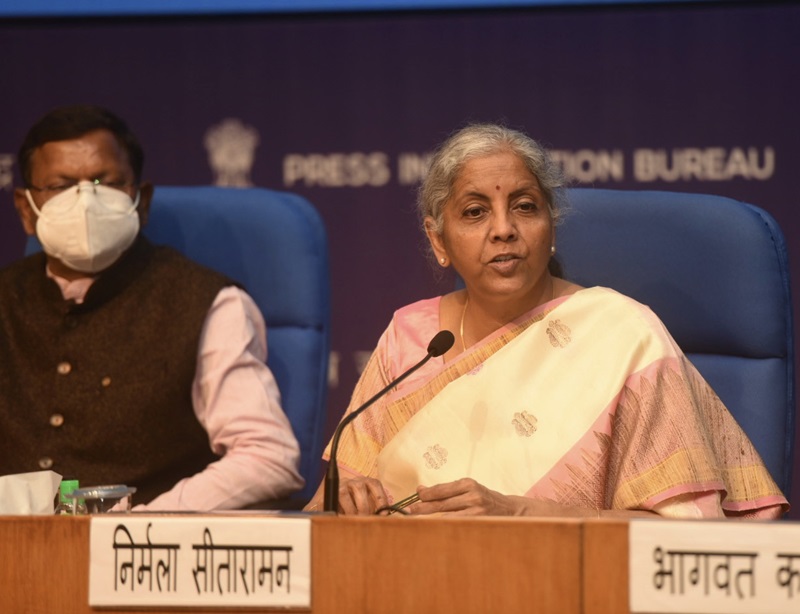.png)
Does The Budget Have The Bandwidth To Resurrect Growth?
India’s macroeconomic outlook is constrained by sluggish corporate profits, weak private capex, and declining household incomes, raising concerns ahead of the 2025-26 Budget. Despite efforts to pivot towards employment-linked incentives, fiscal tightening and high public debt could limit the government's ability to drive growth.


Dhananjay Sinha, CEO and Co-Head of Institutional Equities at Systematix Group, has over 25 years of experience in macroeconomics, strategy, and equity research. A prolific writer, Dhananjay is known for his data-driven views on markets, sectors, and cycles.
January 30, 2025 at 9:11 AM IST
Ahead of the Union Budget announcement, India’s macro conditions are beset with a concomitant decline in corporate profits, persistently lagging private capex, dipping household earnings and spending sentiment, paucity of deposits impeding the lending capability of banks and the adverse wealth effect from a steep ₹68 trillion erosion of market cap of Indian equity markets since September 2024, which is larger than the 2024-25 Budget by a multiple of 1.4 times.
The key question is whether the central government can show the intent or has the bandwidth to untangle the structural and cyclical logjam.
In assessing that, we need to look at the factors at play.
First, with rising ruralisation associated with declining migration, rising dependence on agriculture sector occupation, and decelerating urban growth, productivity erosion led to a scenario of growth remaining lower for longer. The real challenge is that a sub-9% nominal GDP growth (Advance estimate for nominal GDP growth is 9.7%), lower than the usual budget assumption of 10.5%, can have serious ramifications for fiscal calculations, including tax buoyancy, spending trade-offs, and debt sustainability, thereby further limiting the fiscal bandwidth.
Second, the intense supply-side fiscal strategy over the past seven to eight years, including corporate tax cuts, heavy infrastructure sector outlays, and the burgeoning central government debt, has failed to crowd in private capex and employment generation. With corporate profits contracting now following the episodic post-pandemic boom, private capex can further diminish, thereby challenging the justification of exuberant government capex.
Third, the lack of positive externalities from the supply-side strategy and high public debt have intensified fiscal prudence, leading to peak levels of tax incidence on households alongside the reduction in subsidies, even while real household income growth has decelerated to a 40-year low of 3.5% (5-year CAGR). This has led to persistent weak demand and a downward business spiral.
These multifarious constraints have political ramifications, compelling a pivot in the post-election Union Budget 2024-25 towards directly addressing the employment problem, depicted by a shift from the Production Linked Incentive programme to Employment Linked Incentives. But despite the shift, the growth cycle has worsened, indicating a negligible impact of the fiscal pivot.
On the contrary, the provisional data for April-November 2024 indicates that the intent of fiscal containment has been overwhelmed with spending growth of just 3.3% year on year, the lowest in 20 years and compared to the budgeted 8.5% for 2024-25, with a significant curtailment in capital allocation (-12.3%) and higher revenue spending of 7.8%.
This is despite the bountiful ₹2.11 trillion dividend from the RBI. The pace of tax revenue collection (10.7% year on year) is seemingly in line with the budget target, primarily due to strong income tax collections in the April-June quarter, which were boosted by lower tax refunds. However, following the initial buoyancy, tax revenue collection has slowed considerably. Gross collections decelerated to 4.4% during July-November with contracting corporate taxes (-10.14% year on year, vs 0.5% year to date) and decelerating income tax (10.1% vs 23.5% year to date). And non-debt capital receipts have remained stagnant.
Given the rigid adherence to the fiscal deficit glide path amid structural and cyclical slowdowns, the budget strategy is likely to remain on a tightening trajectory. The fiscal deficit is expected to decline to 4.8%, lower than the budgeted 4.9%, with a further reduction to 4.4% expected for 2025-26. With spending growth lagging GDP, the falling fiscal deficit-to-GDP ratio will imply procyclical fiscal tightening, exacerbating fiscal drag.
With government debt rising to ₹182 trillion (2024-25 Budget Estimate), rising by ₹80 trillion over five years or 1.54 times incremental worker income, interest payments as a proportion of overall revenue expenditure are set to rise to a peak of 32% for 2024-25 year-to-date (31.4% Budget Estimate and 29.6% Apr-Nov). At the broader level, the combined government debt of the centre and states at ₹270 trillion (2024-25 Estimate) has increased by 2.2 times incremental household incomes. While it has intensified the spending trade-offs within the overall lower spending, it is also weighing on households through stepped-up taxes, particularly net indirect taxes.
Entwining structural constraints typify the constrictor knot; the Budget is unlikely to provide a comprehensive redress. The budget could combine fiscal consolidation, i.e., remain a demand drag, with extra-budgetary instruments, including greater reliance on public sector entities. Hence, the following can be expected.
- Rebalancing the spending profile - by lowering the pace of capital outlay with an overall spending growth of 6-7% and fiscal deficit assumption of ₹15.7 trillion in 2025-26.
- Refocusing towards the revival of the rural economy and some easing of income tax incidence.
- The inclusion of G-sec in the global index also impels the Centre's fiscal consolidation. This implies that the burden of fiscal support will be funnelled through state budgets, implying increased tax devolution to states.
- Use of PSEs as an extension of a fiscal arm. There is a possibility of relenting on disinvestments and using their resources for mandated employment generation or dividend payouts from oil PSUs, Coal India, and PSU banks.
- PSU banks may be directed to infuse more lending in rural areas, in line with the RBI's recent directives to increase uncollateralised agriculture lending.
- The use of the RBI balance sheet to monetise government borrowings and manage the government bond yield curve, especially in the context of weakening USD/INR and the drain of the RBI forex reserve.
Overall, the challenges for India’s growth outlook are daunting. An additional complication is the risk of global trade protectionism emanating from the Trump 2.0 global setup, which can be a significant cause for concern. Markets, households, and corporates are losing confidence, and it will be paramount for the central government to implement both immediate strategy and long-term cogent structural policy response to veer out of the macro entanglement.



